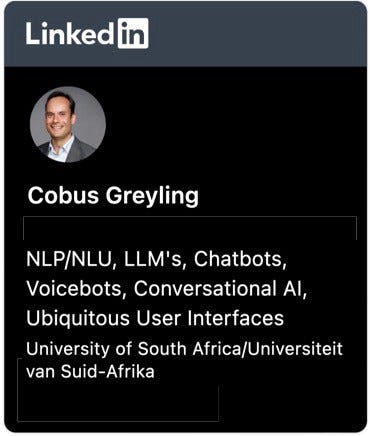The Foundation Large Language Model (LLM) & Tooling Landscape
There is an ever growing list of Generative AI Applications, which can be broken down into eight broad categories.
“Software is eating the world…”
~ Marc Andreessen
Every company is a software company…soon every company will be an AI company.
Everybody is using software…soon everybody will directly be using AI.
⭐️ Please follow me on LinkedIn for updates on Conversational AI ⭐️
While creating this matrix for generative AI applications I was amazed at how many new applications there were, and how many of those were still in closed beta testing, access pending an approval process (waiting list) or available soon.
The sheer number of Content & Idea Creation and Writing assistants are staggering.
Without doubt this is not sustainable and a significant shakeout is pending for many of these applications. As I mentioned in a previous post, true value add and differentiation will be demanded for survival.
As native LLM functionality grows and their user interfaces mature, LLM-based applications without considerate IP and propriety value-add will disappear.
To some extend the LLM market is naive, and as user knowledge and insight grows, products which are really just a thin client acting as an extension to LLMs will not survive. It is analogous to the flashlight apps being superseded by a button in the OS.
In November 2022 Base10 released a map of the Generative AI landscape which is a very good reference and overview of the Generative AI software landscape.
The map below was compiled by me and considers two elements:
1️⃣ Foundational Large Langauge Models & Data Centric Tools
A collection of Foundation LLMs and data centric tools are at the base of the stack. These models and tools are foundational in the sense that it serves as foundation-level enablers.
2️⃣ Nascent Generative Langauge AI Tools
There has been an explosion of Generative AI based applications, especially in the area of Content & Idea Creation, Writing Assistants & Generative & Search Assistants.
Content & Idea Creation is the most accessible feature of LLM based Generative AI. Together with Writing Assistant features. Little wonder that the most products are found in these categories.
The two areas of differentiation and survival for these products are:
Propriety value-add which sits between the LLM and the UI, and this layer needs to be exceptional in terms of augmenting the LLM API.
The second element of differentiation is UX. The User Experience also needs to be stellar to contribute to user retention.
The third most prevalent area of implementation is Generative & Search Assistants. This is basically conversation-based semantic search, with uploaded content acting as the knowledge base. The Data Extraction & Conversational Search category does very much the same, just on a larger scale.
However, the area that interests me the most, and where I believe the most potential and growth lies, is with Build Frameworks. Build Frameworks are still in a nascent state, but principles are starting to emerge, in terms of:
Templating Prompts to make Prompts re-useable and programable.
Archiving, re-using and sharing of prompts.
Creating complex APIs which can facilitate multiple requests which are executed in series or parallel.
Blocks with code logic to determine the next block to execute.
Multiple Foundation Systems can be accessed and leveraged.
In Closing
The expansion in Generative AI products are phenomenal and a contraction is inevitable.
Key elements for survival will include:
🛟 An existing & growing Customer base
🛟 Customer retention
🛟 Stellar User Experience and UI
🛟 Propriety and truly differentiating IP & software
Lastly, to again illustrate the crowded nature of the Generative AI space, consider the image below.
It shows just some of the numerous Chrome Web Extensions which are GPT or ChatGPT based…
⭐️ Please follow me on LinkedIn for updates on Conversational AI ⭐️
I’m currently the Chief Evangelist @ HumanFirst. I explore and write about all things at the intersection of AI and language; ranging from LLMs, Chatbots, Voicebots, Development Frameworks, Data-Centric latent spaces and more.







